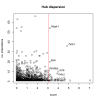Meta-analysis approach identifies candidate genes and associated molecular networks for type-2 diabetes mellitus
- PMID: 18590522
- PMCID: PMC2515154
- DOI: 10.1186/1471-2164-9-310
Meta-analysis approach identifies candidate genes and associated molecular networks for type-2 diabetes mellitus
Abstract
Background: Multiple functional genomics data for complex human diseases have been published and made available by researchers worldwide. The main goal of these studies is the detailed analysis of a particular aspect of the disease. Complementary, meta-analysis approaches try to extract supersets of disease genes and interaction networks by integrating and combining these individual studies using statistical approaches.
Results: Here we report on a meta-analysis approach that integrates data of heterogeneous origin in the domain of type-2 diabetes mellitus (T2DM). Different data sources such as DNA microarrays and, complementing, qualitative data covering several human and mouse tissues are integrated and analyzed with a Bootstrap scoring approach in order to extract disease relevance of the genes. The purpose of the meta-analysis is two-fold: on the one hand it identifies a group of genes with overall disease relevance indicating common, tissue-independent processes related to the disease; on the other hand it identifies genes showing specific alterations with respect to a single study. Using a random sampling approach we computed a core set of 213 T2DM genes across multiple tissues in human and mouse, including well-known genes such as Pdk4, Adipoq, Scd, Pik3r1, Socs2 that monitor important hallmarks of T2DM, for example the strong relationship between obesity and insulin resistance, as well as a large fraction (128) of yet barely characterized novel candidate genes. Furthermore, we explored functional information and identified cellular networks associated with this core set of genes such as pathway information, protein-protein interactions and gene regulatory networks. Additionally, we set up a web interface in order to allow users to screen T2DM relevance for any - yet non-associated - gene.
Conclusion: In our paper we have identified a core set of 213 T2DM candidate genes by a meta-analysis of existing data sources. We have explored the relation of these genes to disease relevant information and - using enrichment analysis - we have identified biological networks on different layers of cellular information such as signaling and metabolic pathways, gene regulatory networks and protein-protein interactions. The web interface is accessible via http://t2dm-geneminer.molgen.mpg.de.
Figures






References
-
- Jackson Labs Human Disease and Mouse Model Detail for NIDDM
-
- Frayling TM, Timpson NJ, Weedon MN, Zeggini E, Freathy RM, Lindgren CM, Perry JR, Elliott KS, Lango H, Rayner NW, Shields B, Harries LW, Barrett JC, Ellard S, Groves CJ, Knight B, Patch AM, Ness AR, Ebrahim S, Lawlor DA, Ring SM, Ben-Shlomo Y, Jarvelin MR, Sovio U, Bennett AJ, Melzer D, Ferrucci L, Loos RJ, Barroso I, Wareham NJ, Karpe F, Owen KR, Cardon LR, Walker M, Hitman GA, Palmer CN, Doney AS, Morris AD, Smith GD, Hattersley AT, McCarthy MI. A common variant in the FTO gene is associated with body mass index and predisposes to childhood and adult obesity. Science. 2007;316:889–894. doi: 10.1126/science.1141634. - DOI - PMC - PubMed
Publication types
MeSH terms
LinkOut - more resources
Full Text Sources
Other Literature Sources
Medical
Miscellaneous

